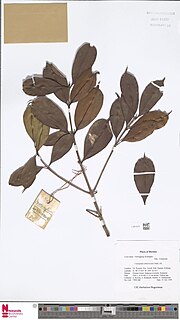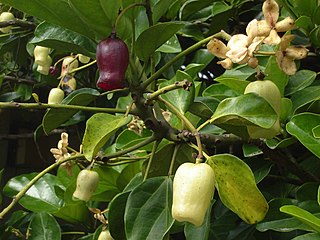
Cratoxylum arborescens is a plant in the family Hypericaceae. The specific epithet arborescens is from the Latin meaning "tree-like".
Atuna cordata is a tree in the Atuna genus of the family Chrysobalanaceae. The specific epithet cordata is from the Latin meaning "heart-shaped", referring to the leaf base.

Atuna is a genus of plants in the family Chrysobalanaceae described as a genus in 1838. It is native to India, Southeast Asia, and various islands of the western Pacific.
Brackenridgea palustris is a tree in the family Ochnaceae. The specific epithet palustris is from the Latin meaning "swampy", referring to the species' habitat.
Euthemis minor is a plant in the family Ochnaceae. The specific epithet minor is from the Latin meaning "small", referring to the species' smaller size when compared with E. leucocarpa.
Parinari argenteo-sericea is a tree of Borneo in the family Chrysobalanaceae. The specific epithet argenteo-sericea is from the Latin meaning "silvery silky", referring to the pubescence of the inflorescence and flowers.
Schrebera kusnotoi is a plant in the family Oleaceae. It grows as a tree up to 45 metres (148 ft) tall, with a trunk diameter of up to 90 centimetres (35 in). The flowers are white. Fruit is obovoid, up to 7 centimetres (2.8 in) long. Habitat is forests from sea level to 1,600 metres (5,200 ft) altitude. S. kusnotoi is endemic to Borneo.
Helicia excelsa is a plant in the family Proteaceae. It grows as a tree up to 20 metres (70 ft) tall, with a trunk diameter of up to 25 centimetres (10 in). The bark is dark grey to blackish. Inflorescences bear up to three reddish brown flowers. Fruit is black, ellipsoid, up to 3 centimetres (1 in) long. The specific epithet excelsa is from the Latin meaning "lofty", referring to the tree's growth. Habitat is forests from sea level to 1,700 metres (5,600 ft) altitude. H. excelsa is found in Bangladesh, Burma, Thailand, Malaysia and Indonesia.
Helicia maxwelliana is a plant in the family Proteaceae. It grows as a treelet up to 3 metres (10 ft) tall. The twigs are dark brown. The flowers are reddish brown. The fruit is black, round, up to 2.5 centimetres (1 in) in diameter. Its habitat is montane forest at 1,600 metres (5,200 ft) to 1,700 metres (5,600 ft) altitude. H. maxwelliana is endemic to Borneo.
Helicia pterygota is a plant in the family Proteaceae. It grows as a shrub or small tree up to 7 metres (20 ft) tall, with a stem diameter of up to 6 centimetres (2 in). The bark is brownish. The specific epithet pterygota is from the Greek meaning "winged", referring to the pedicel. Habitat is forests from 1,000 metres (3,300 ft) to 1,800 metres (6,000 ft) altitude. H. pterygota is endemic to Borneo where it is confined to Mount Kinabalu in Sabah.
Heliciopsis velutina is a species of trees, in the family Proteaceae. They grow up to 25 metres (80 ft) tall, with a trunk diameter of up to 25 cm (10 in). The bark is dark brown. They have reddish brown flowers. They have brown, ellipsoid fruits up to 4 cm (2 in) long. The specific epithet velutina comes from the Latin meaning "velvety", referring to the petiole. They grow naturally in lowland mixed dipterocarp forests' habitats from sea level to 600 metres (2,000 ft) altitude in Peninsular Malaysia and Borneo.
Diospyros alatella is a tree in the family Ebenaceae. It grows up to 33 metres (110 ft) tall. The fruits are solitary, up to 4.5 cm (2 in) in diameter. The specific epithet alatella is from the Latin meaning "with small wing", referring to the fruit. Habitat is forests from sea level to 1,200 metres (3,900 ft) altitude. D. alatella is endemic to Borneo and confined to Sarawak.
Diospyros fusiformis is a tree in the family Ebenaceae. It grows up to 15 metres (50 ft) tall. Inflorescences bear up to 10 flowers. The fruits are ovoid to spindle-shaped, up to 4 cm (1.6 in) in diameter. The specific epithet fusiformis is from the Latin meaning "spindle-shaped", referring to the fruits. Habitat is mixed dipterocarp forests from sea level to 600 metres (2,000 ft) altitude. D. fusiformis is endemic to Borneo.
Diospyros squamifolia is a small tree in the family Ebenaceae. It grows up to 5 metres (20 ft) tall. The fruits are round, up to 1.5 cm (1 in) in diameter. The specific epithet squamifolia is from the Latin meaning "scale-like leaf", referring to the fish scale shape of the leaves. Its habitat is lowland mixed dipterocarp forests. D. squamifolia is endemic to Borneo and known only from Sabah.

Dysoxylum parasiticum, known as yellow mahogany, is a species of rainforest trees in the family Meliaceae. The specific epithet parasiticum is from the Latin meaning "parasitic", referring to the idea that the flowers are parasitic on another tree species.
Parinari canarioides is a tree in the family Chrysobalanaceae. The specific epithet canarioides is for the species' resemblance to the genus Canarium.
Parinari metallica is a tree in the family Chrysobalanaceae. The specific epithet metallica is from the Latin meaning "metallic", referring to the metallic sheen on the leaves when dried.
Parinari rigida is a tree in the family Chrysobalanaceae. The specific epithet rigida is from the Latin meaning "stiff", referring to the leaves.
Engelhardia roxburghiana is a tree in the family Juglandaceae. It is named for the Scottish botanist William Roxburgh.

Atuna racemosa is a tree in the family Chrysobalanaceae. The specific epithet racemosa is from the Latin meaning "clustered", referring to the inflorescence. The tree is widely known as tabon-tabon in the Philippines, where the fruits have been traditionally used for the preparation of kinilaw for almost a thousand years.


